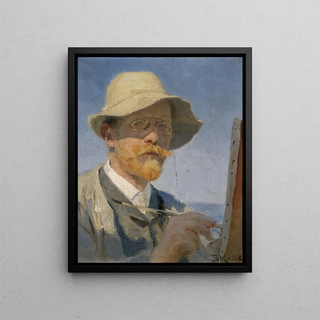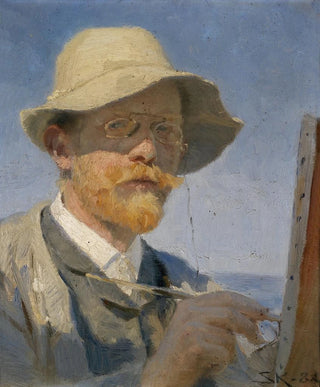Art print | Self-portrait - Peder Severin Krøyer


View from behind

Frame (optional)
Peder Severin Krøyer's self-portrait is much more than a simple artwork; it is an open window into the soul of an artist who captured the very essence of his era. This painting, created at the end of the 19th century, embodies not only Krøyer's undeniable talent but also the artistic and cultural upheavals characteristic of the modernist period. In this work, the artist engages in visual introspection, depicting himself with an intensity that invites the viewer to delve into his thoughts and emotions. Through the brushstrokes, a psychological depth is felt that transcends a mere self-portrait to become a reflection on identity and artistic creation.
Style and uniqueness of the work
Krøyer's style is distinguished by his masterful use of light and color, essential elements of his Impressionist technique. In this art print, he manages to create an atmosphere that is both intimate and universal, where light plays a central role. The delicate nuances of his palette evoke a sense of softness and melancholy, while subtle shadows add a dimension of depth to his face. Every detail, every reflection, is carefully thought out to convey a precise emotion. The artist does not merely depict himself; he reveals himself, offering a glimpse into his inner thoughts and creative struggles. This piece is a true ode to the beauty of art, the quest for self, and the passion that drives every creator.
The artist and his influence
Peder Severin Krøyer, an emblematic figure of the Danish artistic movement, left a mark on his era through his innovative approach to painting. Born in 1851, he was influenced by the great European masters while developing a style that was uniquely his own. His commitment to light and color paved the way for many contemporary and subsequent artists. Krøyer also played a key role in establishing the Skagen artistic colony, where he gathered painters seeking to capture the beauty of Danish landscapes. His influence is still felt today, both through his technique and his approach to artist representation.

Matte finish

View from behind

Frame (optional)
Peder Severin Krøyer's self-portrait is much more than a simple artwork; it is an open window into the soul of an artist who captured the very essence of his era. This painting, created at the end of the 19th century, embodies not only Krøyer's undeniable talent but also the artistic and cultural upheavals characteristic of the modernist period. In this work, the artist engages in visual introspection, depicting himself with an intensity that invites the viewer to delve into his thoughts and emotions. Through the brushstrokes, a psychological depth is felt that transcends a mere self-portrait to become a reflection on identity and artistic creation.
Style and uniqueness of the work
Krøyer's style is distinguished by his masterful use of light and color, essential elements of his Impressionist technique. In this art print, he manages to create an atmosphere that is both intimate and universal, where light plays a central role. The delicate nuances of his palette evoke a sense of softness and melancholy, while subtle shadows add a dimension of depth to his face. Every detail, every reflection, is carefully thought out to convey a precise emotion. The artist does not merely depict himself; he reveals himself, offering a glimpse into his inner thoughts and creative struggles. This piece is a true ode to the beauty of art, the quest for self, and the passion that drives every creator.
The artist and his influence
Peder Severin Krøyer, an emblematic figure of the Danish artistic movement, left a mark on his era through his innovative approach to painting. Born in 1851, he was influenced by the great European masters while developing a style that was uniquely his own. His commitment to light and color paved the way for many contemporary and subsequent artists. Krøyer also played a key role in establishing the Skagen artistic colony, where he gathered painters seeking to capture the beauty of Danish landscapes. His influence is still felt today, both through his technique and his approach to artist representation.






